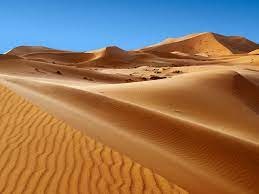Why did the Sahara desert become brown when it was previously green?
The Sahara Desert, famous for its enormous tract of parched territory, sweltering heat, and towering sand dunes, wasn’t always the desolate region we perceive it as today. In reality, the Sahara was once a lush, green zone filled with life millions of years ago. Scientists and historians have been captivated by this amazing shift from a lush oasis to a wide desert for decades. Let’s go through time to see how the Sahara Desert evolved into the dry wasteland it is today.
The Green Sahara: An Ancient Paradise
The Pleistocene Period
The Pleistocene period, which lasted from around 2.6 million to 11,700 years ago, saw a significant change in the Sahara Desert’s landscape. Instead, it was a lush area with lakes, rivers, and a lot of greenery. The Sahara housed a variety of plant and wildlife, including early human settlements, and the climate was much wetter.
The arid season in Africa
About 10,000 years ago, when the Sahara was at its greenest, it went through a period known as the “African Humid Period.” During this period, the Sahara received monsoonal rains from the African monsoon, which nourished the soil and produced a lush environment. The Sahara’s abundance of ancient rock art sites provides evidence that there was a vibrant human civilisation at this time.
The Causes of Desertification
Orbital Forcing (#)
Changes in Earth’s orbital parameters may be partly blamed for the Sahara’s conversion to a desert. These modifications affected the way solar radiation was distributed, which in turn affected the monsoon systems that provided rain to the area. The African monsoon steadily weakened due to changes in the Earth’s orbit, which caused the Sahara to dry up over time.
Human Impact #
Human actions have had a part in the desertification of the Sahara, but less significantly than natural reasons. Early human groups were compelled to adapt as the environment became drier. While some chose pastoralism, others engaged in agriculture. Increased agricultural production may have accelerated the desertification process over time by causing soil erosion and deforestation.
The Shocking Truths of the Modern Sahara
Climate Conditions Right Now
The Sahara Desert is one of the hardest places on Earth right now. It has a surface area of around 3.6 million square miles and is distinguished by sand dunes, scorching temperatures, and few flora. The majority of plant and animal life cannot survive the intermittent and scant rainfall.
Climate Change and Projections for the Future
While much of the Sahara’s evolution is the product of natural processes, the current state of climate change presents new difficulties. Rising global temperatures and changed weather patterns may cause the Sahara’s limits to grow even farther, affecting not just the people who live there but also those in nearby areas.
in the horizon, hope
Environmental Restoration Initiatives
There is hope for the rehabilitation of certain areas of the Sahara despite the difficulties. There are several activities being carried out to stop desertification, including reforestation plans, water management plans, and sustainable agricultural methods. With these initiatives, the area will be revitalized and local residents’ quality of life will be raised.
### Future-Prospective Lessons
The tale of the Sahara’s metamorphosis serves as a sobering reminder of how the climate of the Earth is always changing. It emphasizes how precarious the harmony between the forces of nature and human activity is. Scientists may learn a lot about how ecosystems can adapt and how crucial sustainable practices are in reducing the effects of climate change by examining the history of the Sahara.
In conclusion, the Sahara Desert’s transformation from a lush haven to a desolate wasteland is evidence of the Earth’s mutable character. The renowned desert has been impacted by human activity in addition to climate change and natural processes. Lessons from the history of the Sahara may direct our efforts to conserve and safeguard the world for future generations as we deal with the difficulties of a changing climate.







